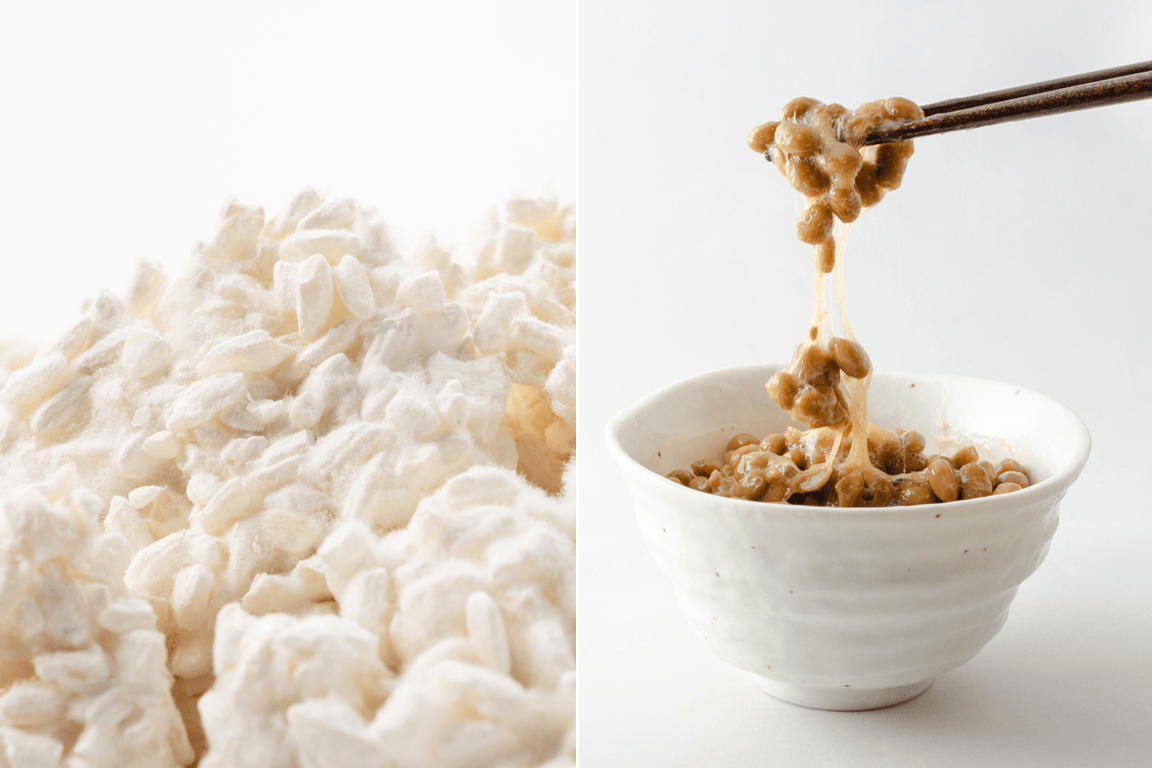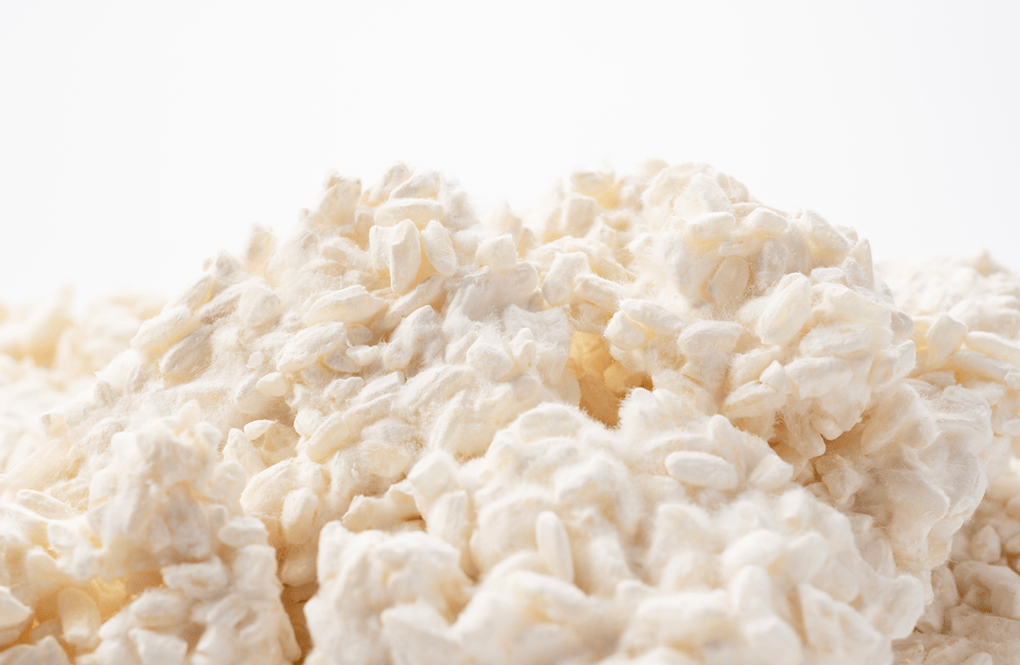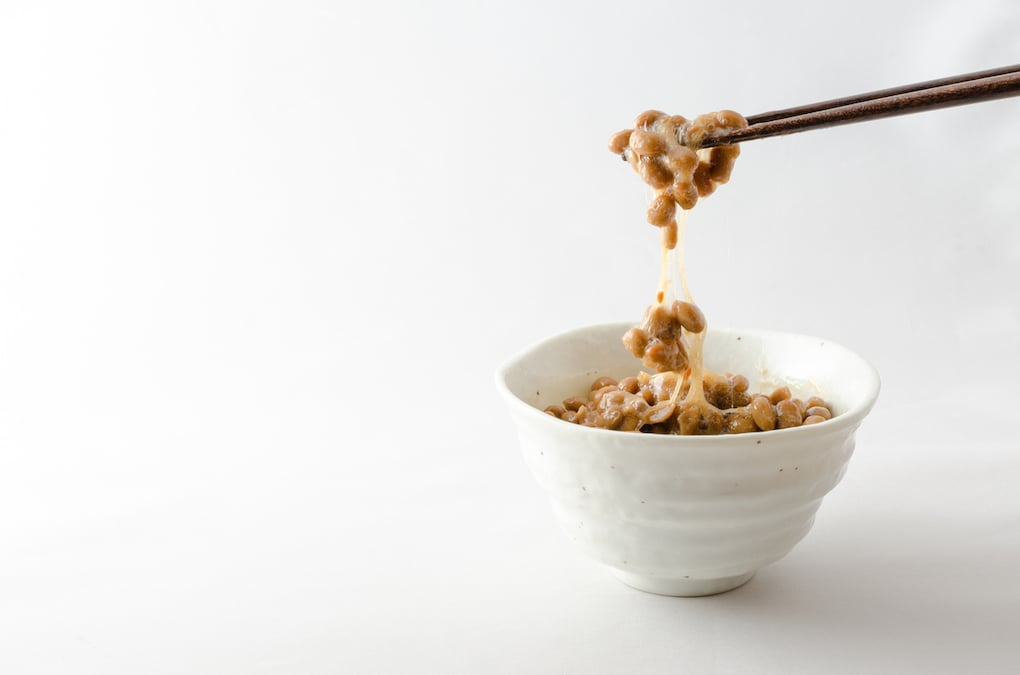
Unlocking Umami
Navigating the bold flavors of natto and koji in modern cuisine
Unlocking Umami
Navigating the bold flavors of natto and koji in modern cuisine
By Katie Ayoub
December 7, 2023
By Katie Ayoub
December 7, 2023
In the ongoing quest to dial up umami and deliver on the promise of craveability, it’s worth diving into the modern menu potential of two distinctive ingredients: koji and natto. Koji, a mold cultivated on grains like rice, has found the culinary spotlight in today’s professional kitchens. Chefs across the country are exploring its umami-rich essence and using it to elevate both plant-based and animal protein dishes. Natto, a fermented soybean dish from Japan, offers menu developers an assertive, earthy, nutty and somewhat acidic flavor profile. Although lesser known in this country, natto promises serious umami coupled with a compelling health-and-wellness story.
We sat down with Pam Smith, RDN, founder of Orlando, Fla.-based Shaping America’s Plate, a menu/concept/flavor consultancy, to get her insights and ideas on both of these ingredients:

Koji, sometimes affectionately known as the “national mold of Japan,” is the key ingredient behind miso, soy sauce, sake, mirin and more.
KOJI
Katie Ayoub: Koji is having a moment in foodservice. What is its superpower?
Pam Smith: A moment, indeed! Chefs have wholeheartedly embraced the unique flavor of koji—the mold-inoculated grains behind miso, soy sauce, sake and mirin. Their passion is catching on. In their book, The Noma Guide to Fermentation, Noma chef René Redzepi and fermentation lab head David Zilber described koji as “indistinguishable from magic.”
KA: How do you describe its flavor-boosting ability?
PS: To understand how it boosts flavor, it’s helpful to learn what it is. Koji, also known as koji-kin in Japan, is a fungus (Aspergillus oryzae) that has been used in Japanese, Chinese and Korean cooking for thousands of years. Much like yeast starters in bread making, koji kickstarts the fermentation process when it’s applied to grains, soybeans, rice and barley. With the right temperature and humidity levels, the mold will yield enzymes that release glutamates from the base protein. So, starches and proteins transform into sugars and amino acids. The resulting flavors are the essence of umami: sweet, savory, salty—with an undertone of something hard to identify, but intensely craveable. This inoculated grain is koji. It can then be used to bring out the sugars in rice to be fermented into amazake (sweet rice porridge), mirin and sake. Or koji’s magic can be used to unravel the proteins in pulses and grains to produce savory and umami-rich miso pastes, soy sauces and shōyu.
KA: Please share a few ways chefs can leverage koji in modern menu development.
PS: Chefs are finding great flavor success whether using koji’s magic in plant-based menu development or enhancing animal proteins, simultaneously bringing out the natural sweetness of the product with a savory, meaty quality—it’s a win-win. They also love the versatility of this ingredient. No matter the protein or produce, koji imparts so much umami, then flavor follows.
KA: Tell us about koji’s role in high-impact ingredients like miso and shōyu.
PS: These ingredients are amazing tools in modern menu development. Miso paste is made by combining koji molds with cooked soybeans, salt and water and allowing the mixture to develop both its unique texture and umami power. Chefs are using miso paste in condiments such as aïoli and ketchup and in glazes, marinades and gravies to drive craveability. It’s a functional curing and pickling agent, as well as a base for memorable and tasty soups and sauces. Shōyu is a Japanese-style soy sauce made using a similar technique to miso paste, namely applying koji molds to a soybean and salt mash and allowing fermentation to occur. It’s then taken a step further; the mixture is pressed and filtered to create a seasoning liquid that’s now used around the globe.
KA: What does koji bring to the table from a health and wellness perspective?
PS: Like other fermented foods, koji is beneficial due to the probiotics it contains, which are friendly gut bacteria that can improve digestion and overall well-being. Koji contains a compound called glycosylceramide that functions as a prebiotic to feed healthy gut bacteria.
 Photo Credit: Getty Images
Photo Credit: Getty Images Although natto (made from fermented soybeans) is a breakfast staple in Japan, its umami-packed flavor profile plays well in dishes like Japanese curry, plant-based sushi and noodle bowls.
NATTO
KA: As you work closely with U.S. Soy, I understand you are well-versed in the power and potential of natto. How do you describe the flavor profile of natto to the uninitiated?
PS: Natto, a bit like Marmite, Vegemite or limburger, stirs up intense feelings of love or hate; it’s rare to find an in-between. A traditional Japanese food made from fermented soybeans, natto’s pungent aromatics—often compared to stinky cheese—play a key role in its distinctive flavor: earthy, nutty, somewhat acidic or bitter. A breakfast staple in many parts of Japan, it’s often mixed with raw egg, served with rice, pickles and miso soup, and complemented by soy sauce, karashi mustard and green onion. Eaten alone, for the uninitiated, it has all the makings of a TikTok food challenge.
KA: What is the menu opportunity for chefs in the U.S.?
PS: The flavor play here lies in natto’s unctuousness: a deep and rich umami flavor. And its texture and stringy attributes provide a creative playground for chefs to stretch a dish into new places. Natto enthusiasts share that the best way to prepare natto is to first mix it on its own without any seasonings added—the more natto is mixed, the more the umami flavor develops.
KA: Please share a few ways that chefs can leverage natto in modern menu development.
PS: Natto is a nutrient-rich plant protein and provides a unique, flavor-rich tool in plant-based menu development. Beyond its traditional Japanese breakfast usage, natto plays well in plant-based sushi, pasta, udon noodles bowls or Japanese curry. It also works both blended with or as a topping to soft/silken tofu. Natto adds texture and complexity to salad dressings, mayo-based condiments, fried rice, omelettes and avocado toast. And it can pair well with a myriad of other ingredients, like soy sauce, miso, ginger, nori, kimchi, green onions, mushrooms, soft tofu and cheese. Chefs can utilize different varieties of natto, based on their use of it. Otsubu is made from big beans and doesn’t get as sticky as smaller beans; it’s most often served on its own as a side dish or in miso soup. Kotsubu, best served with rice or noodles, is made from small beans and is a bit stickier. Hikiwari is made from crushed beans and is a good choice when cooking with natto since the texture isn’t as chunky.
KA: What does natto bring to the table from a health and wellness perspective?
PS: Natto contains all the healthful nutrients found in soybeans: high-quality protein, minerals, vitamins and prebiotic-rich fiber, which is known to support immune, gut, heart and bone health. The fermentation brings even more to the table; natto is also rich in probiotics and other bioactive compounds that may offer health benefits. And, the sticky, stringy characteristic of natto (known as neba-neba in Japanese) is where many nutrients are found. During the fermentation and aging process, the natto bacterium breaks down the proteins in the soybeans into amino acids, including glutamic acid (which makes glutamate, the compound responsible for umami flavor). The glutamic acid forms long, folded chains that result in natto’s sticky strands.
In the ongoing quest to dial up umami and deliver on the promise of craveability, it’s worth diving into the modern menu potential of two distinctive ingredients: koji and natto. Koji, a mold cultivated on grains like rice, has found the culinary spotlight in today’s professional kitchens. Chefs across the country are exploring its umami-rich essence and using it to elevate both plant-based and animal protein dishes. Natto, a fermented soybean dish from Japan, offers menu developers an assertive, earthy, nutty and somewhat acidic flavor profile. Although lesser known in this country, natto promises serious umami coupled with a compelling health-and-wellness story.
We sat down with Pam Smith, RDN, founder of Orlando, Fla.-based Shaping America’s Plate, a menu/concept/flavor consultancy, to get her insights and ideas on both of these ingredients:

Koji, sometimes affectionately known as the “national mold of Japan,” is the key ingredient behind miso, soy sauce, sake, mirin and more.
KOJI
Katie Ayoub: Koji is having a moment in foodservice. What is its superpower?
Pam Smith: A moment, indeed! Chefs have wholeheartedly embraced the unique flavor of koji—the mold-inoculated grains behind miso, soy sauce, sake and mirin. Their passion is catching on. In their book, The Noma Guide to Fermentation, Noma chef René Redzepi and fermentation lab head David Zilber described koji as “indistinguishable from magic.”
KA: How do you describe its flavor-boosting ability?
PS: To understand how it boosts flavor, it’s helpful to learn what it is. Koji, also known as koji-kin in Japan, is a fungus (Aspergillus oryzae) that has been used in Japanese, Chinese and Korean cooking for thousands of years. Much like yeast starters in bread making, koji kickstarts the fermentation process when it’s applied to grains, soybeans, rice and barley. With the right temperature and humidity levels, the mold will yield enzymes that release glutamates from the base protein. So, starches and proteins transform into sugars and amino acids. The resulting flavors are the essence of umami: sweet, savory, salty—with an undertone of something hard to identify, but intensely craveable. This inoculated grain is koji. It can then be used to bring out the sugars in rice to be fermented into amazake (sweet rice porridge), mirin and sake. Or koji’s magic can be used to unravel the proteins in pulses and grains to produce savory and umami-rich miso pastes, soy sauces and shōyu.
KA: Please share a few ways chefs can leverage koji in modern menu development.
PS: Chefs are finding great flavor success whether using koji’s magic in plant-based menu development or enhancing animal proteins, simultaneously bringing out the natural sweetness of the product with a savory, meaty quality—it’s a win-win. They also love the versatility of this ingredient. No matter the protein or produce, koji imparts so much umami, then flavor follows.
KA: Tell us about koji’s role in high-impact ingredients like miso and shōyu.
PS: These ingredients are amazing tools in modern menu development. Miso paste is made by combining koji molds with cooked soybeans, salt and water and allowing the mixture to develop both its unique texture and umami power. Chefs are using miso paste in condiments such as aïoli and ketchup and in glazes, marinades and gravies to drive craveability. It’s a functional curing and pickling agent, as well as a base for memorable and tasty soups and sauces. Shōyu is a Japanese-style soy sauce made using a similar technique to miso paste, namely applying koji molds to a soybean and salt mash and allowing fermentation to occur. It’s then taken a step further; the mixture is pressed and filtered to create a seasoning liquid that’s now used around the globe.
KA: What does koji bring to the table from a health and wellness perspective?
PS: Like other fermented foods, koji is beneficial due to the probiotics it contains, which are friendly gut bacteria that can improve digestion and overall well-being. Koji contains a compound called glycosylceramide that functions as a prebiotic to feed healthy gut bacteria.
 Photo Credit: Getty Images
Photo Credit: Getty Images Although natto (made from fermented soybeans) is a breakfast staple in Japan, its umami-packed flavor profile plays well in dishes like Japanese curry, plant-based sushi and noodle bowls..
NATTO
KA: As you work closely with U.S. Soy, I understand you are well-versed in the power and potential of natto. How do you describe the flavor profile of natto to the uninitiated?
PS: Natto, a bit like Marmite, Vegemite or limburger, stirs up intense feelings of love or hate; it’s rare to find an in-between. A traditional Japanese food made from fermented soybeans, natto’s pungent aromatics—often compared to stinky cheese—play a key role in its distinctive flavor: earthy, nutty, somewhat acidic or bitter. A breakfast staple in many parts of Japan, it’s often mixed with raw egg, served with rice, pickles and miso soup, and complemented by soy sauce, karashi mustard and green onion. Eaten alone, for the uninitiated, it has all the makings of a TikTok food challenge.
KA: What is the menu opportunity for chefs in the U.S.?
PS: The flavor play here lies in natto’s unctuousness: a deep and rich umami flavor. And its texture and stringy attributes provide a creative playground for chefs to stretch a dish into new places. Natto enthusiasts share that the best way to prepare natto is to first mix it on its own without any seasonings added—the more natto is mixed, the more the umami flavor develops.
KA: Please share a few ways that chefs can leverage natto in modern menu development.
PS: Natto is a nutrient-rich plant protein and provides a unique, flavor-rich tool in plant-based menu development. Beyond its traditional Japanese breakfast usage, natto plays well in plant-based sushi, pasta, udon noodles bowls or Japanese curry. It also works both blended with or as a topping to soft/silken tofu. Natto adds texture and complexity to salad dressings, mayo-based condiments, fried rice, omelettes and avocado toast. And it can pair well with a myriad of other ingredients, like soy sauce, miso, ginger, nori, kimchi, green onions, mushrooms, soft tofu and cheese. Chefs can utilize different varieties of natto, based on their use of it. Otsubu is made from big beans and doesn’t get as sticky as smaller beans; it’s most often served on its own as a side dish or in miso soup. Kotsubu, best served with rice or noodles, is made from small beans and is a bit stickier. Hikiwari is made from crushed beans and is a good choice when cooking with natto since the texture isn’t as chunky.
KA: What does natto bring to the table from a health and wellness perspective?
PS: Natto contains all the healthful nutrients found in soybeans: high-quality protein, minerals, vitamins and prebiotic-rich fiber, which is known to support immune, gut, heart and bone health. The fermentation brings even more to the table; natto is also rich in probiotics and other bioactive compounds that may offer health benefits. And, the sticky, stringy characteristic of natto (known as neba-neba in Japanese) is where many nutrients are found. During the fermentation and aging process, the natto bacterium breaks down the proteins in the soybeans into amino acids, including glutamic acid (which makes glutamate, the compound responsible for umami flavor). The glutamic acid forms long, folded chains that result in natto’s sticky strands.
About the Author
![]() Katie Ayoub serves as managing editor of Flavor & The Menu and content strategist for the Flavor Experience, an annual conference geared toward chain operators. She is president of Katie Ayoub & Associates, serving up menu trends expertise, content creation and food & beverage consultancy. Based in Chicago, Katie has been working in foodservice publishing for more than 20 years and part of the Flavor team since 2006. [email protected]
Katie Ayoub serves as managing editor of Flavor & The Menu and content strategist for the Flavor Experience, an annual conference geared toward chain operators. She is president of Katie Ayoub & Associates, serving up menu trends expertise, content creation and food & beverage consultancy. Based in Chicago, Katie has been working in foodservice publishing for more than 20 years and part of the Flavor team since 2006. [email protected]








